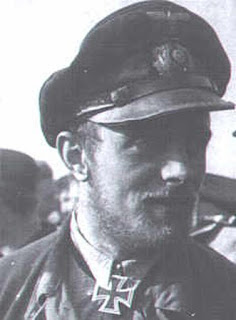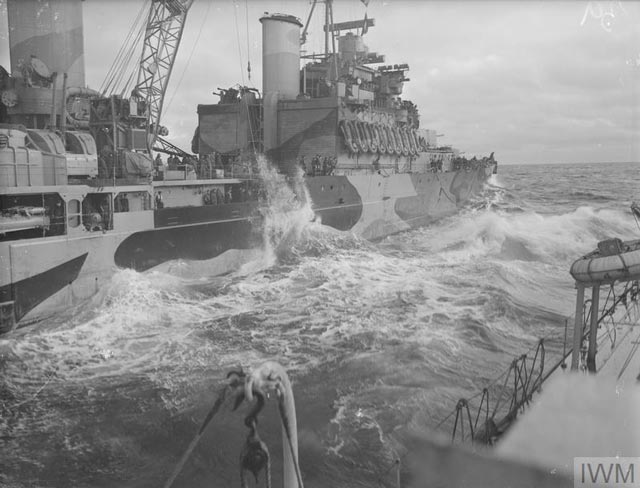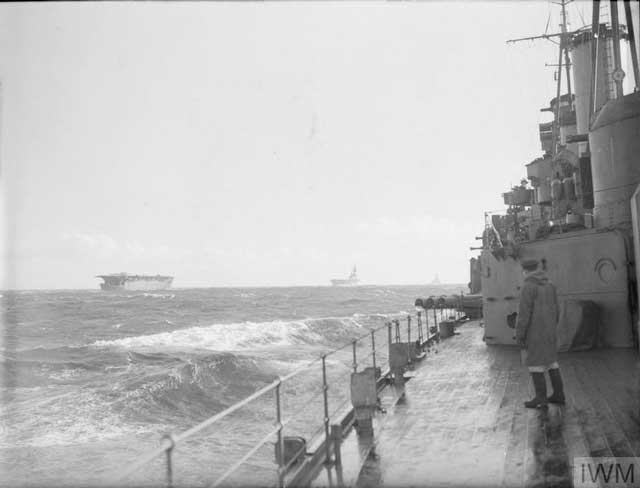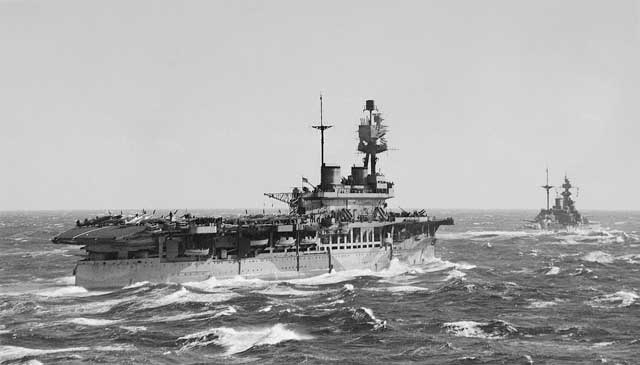Monday 9 March 1942
 |
| RAF warplanes spot the German battleship Tirpitz at sea, 9 March 1942. The Tirpitz appears to have just begun evasive maneuvers. Visible at the top is accompanying destroyer Friedrich Ihn. |
Battle of the Pacific: The Japanese complete the conquest of the Netherlands East Indies on
9 March 1942 when the Dutch commander of Java surrenders along with Governor General Jonkheer A.W.L. Tjarda van Starkenborgh Stachouwer. Observing that some Australian units in the interior continue to hold out, Japanese Lieutenant General Imamura Hitoshi orders Dutch Lt. General Hein Ter Poorten to make another radio broadcast at 14:30 telling them to surrender, which they do. The occupation of the Netherlands East Indies has been a critical Japanese war aim because it is the world's fourth-largest oil exporter after the United States, Iran, and Romania. The Axis now possesses two of the world's top four oil-exporting regions. This begins undisputed Japanese control of the area that lasts until the Japanese surrender in 1945.
Some Dutch authorities manage to escape. The Lieutenant-Governor General of the Netherlands East Indies, Dr. van Mook, arrives in Adelaide. He promises that" "We are here to collect all the forces we can... There should be an end to destroying and retreating." However, Dutch strength in the Pacific effectively has ended for the time being.
The Japanese 35th Infantry Brigade under Major-General Kiyotake Kawaguchi completes the conquest of Borneo. There are still some Allied troops desperately holding out in isolated areas, but their position is hopeless.
 |
| Time Magazine of 9 March 1942 has many war pictures from around the world. At lower left is a photo of the "Flying Tigers" in Burma. |
Japanese forces land on the islands of Buka and Bougainville in the Solomon Islands. Their main intent is to provide flank protection for the main Japanese overseas base at Rabaul, New Britain. The Japanese quickly begin building airfields and naval bases with which they can harass Allied naval and air traffic between the United States and Australia. The Japanese also are looking at further landings in the Solomon Islands to the south at places such as Guadalcanal. At the moment, the Allies have a very weak presence in the Solomon Islands which is made weaker today when the Japanese execute Australian coastwatcher P. Good on Buka Island. Good's execution results from an indiscreet Australian news broadcast of some of Good's information about Japanese shipping movements.
As Japanese landings proceed at Lae and Salamaua, Allied Hudson bombers of No. 32 Squadron attack the convoys in the Huon Gulf, damaging Yokohama Maru and killing three and wounding eight. Japanese ship Asanagi also is lightly damaged off Lae. Meanwhile, Japanese aircraft bomb targets on New Guinea.
Japanese forces complete the occupation of Rangoon, which the British abandoned before they arrived. Rangoon was the key Allied transit hub for Lend-Lease shipments to China, so the Allies must figure out another route to get the supplies across the Himalayas. The British fly the 1st Battalion Royal Inniskilling Fusiliers to Magwe, Burma, where the British are trying to make a last stand in the country. These are the last British reinforcements to reach Burma.
 |
| A Republic P-43A Lancer 41-6687 in flight near Esler Airfield, Louisiana, 9 March 1942 (USAF). |
Eastern Front: The situation is growing critical at Kholm. The trapped German garrison, numbering almost 100,000 men, is barely surviving on each day's flight of supplies brought in by the Luftwaffe. The relief force under Generalmajor Horst von Uckermann remains stalled virtually within sight of the pocket, blocked by Soviet KV tanks. Soviet T-34 tanks are blasting the pocket's defenses, but so far they are holding. Hitler is losing confidence in Uckermann but has no alternatives at the moment. The Luftwaffe is using all of its transport resources from the entire front just to keep the pocket from collapsing.
European Air Operations: During the day, RAF Bomber Command sends six Bostons on a Circus raid to bomb the Mazingarbe fuel depot without loss.
RAF Bomber Command sends another large mission out tonight. With the target being Essen, 187 bombers (187 aircraft, 136 Wellingtons, 21 Stirlings, 15 Hampdens, ten Manchesters, and five Halifaxes) use their Gee direction-finding equipment in poor weather conditions with thick ground haze. The bombers damage 72 buildings and destroy only two. In secondary raids, four bombers attack Emmerich and Oberhausen, nine Wellingtons and Stirlings bomb Boulogne (only four hit the target), and individual bombers attack Schipol and Soesterburg airfields. An additional five Hampdens lay mines in the Frisian Islands.
Overall, the RAF loses two Wellingtons and a Halifax.
 |
| Using standard naval tactics, German gunners aboard the Tirpitz fire into the sea on 9 March 1942 ahead of attacking RAF warplanes to raise a "curtain of water." The British score no hits during this raid and shoot down two attacking planes. |
Battle of the Atlantic: The Royal Navy has been keeping a close eye on a sortie against the Arctic convoys by German battleship Tirpitz and its accompanying fleet ("Operation Sportpalast"). While Admiral Otto Ciliax aboard the Tirpitz already has turned the force back to its port at Fættenfjord, just north of Trondheim (via Vestfjord), the British are determined to catch it at sea. Twelve Fairey Albacore torpedo bombers of RAF No. 832 Squadron from HMS Victorious attack in the morning, but the Tirpitz successfully evades the torpedoes. The Germans lose only three men wounded and shoot down two of the Albacores (four British airmen killed). The Tirpitz then continues on uneventfully to Vestfjord.
While the Tirpitz does no damage to the Arctic convoys, the weather does. In rough seas near pack ice, 253-ton Soviet minesweeper Shera (formerly of the Royal Navy) capsizes in the Barents Sea.
 |
| Italian submarine Enrico Tazzoli in 1941. |
Italian submarine Enrico Tazzoli (Commander Fecia di Cossato), operating off the coast of Florida, torpedoes, shells, and sinks 5785-ton Uruguayan freighter SS Montevideo. There is a degree of irony in this sinking, as the Montevideo was an Italian freighter seized by Uruguayan authorities, renamed, and put into service.
U-94 (Oblt. Otto Ites), on its second patrol out of Lorient, torpedoes and sinks independent 5152-ton Brazilian passenger/freighter SS Cayru about 130 miles off New York. There are 53 deaths and 36 survivors. There seems to be some disagreement about whether it is U-94 that scores this kill, but it is operating in that general area off Montauk Point on 9 March 1942. In any event, a U-boat definitely sinks SS Cayru.
 |
| U-boat Captain Otto Ites of U-94. He later became a dentist. |
U-126 (Kptlt. Ernst Bauer), on its third patrol out of Lorient, torpedoes and sinks independent 8241-ton Panamanian tanker Hanseat about 10 miles northeast of Cape Maysi, Cuba. Two torpedoes hit at 13:17, one in the stem, the other in the stern. The Dutch crew manages to take to the boats before Bauer surfaces and starts shelling the sinking ship, which takes two hours to go under. All 38 men aboard survive.
 |
| "Paying out the oil fuel pipe from the cruiser HMS TRINIDAD which is hauled on board by the destroyer HMS FURY. Note the huge waves pounding the side of the cruiser." © IWM (A 7923). |
U-587 (KrvKpt. Ulrich Borcherdt), on its second patrol out of St. Nazaire, torpedoes and sinks 5719-ton Greek freighter Lily about 470 miles east of Halifax. The Lily technically is part of Convoy ON-68 but is a straggler. There are 29 survivors and 3 dead (who die of exposure after taking to the boats).
U-96 (Kptlt. Heinrich Lehmann-Willenbrock), on its eighth patrol out of St. Nazaire, torpedoes and sinks 4265-ton Norwegian freighter Tyr about 100 miles east of Halifax. The ship sinks within nine minutes. There are 13 dead and 18 survivors. Lehmann-Willenbrock on U-96 stops and gives the survivors directions to Sable Island.
 |
| The view from the Tirpitz on 9 March 1942 as it approaches safety in the Norwegian fjords after attacks by HMS Victorious. |
Battle of the Mediterranean: Radio Berlin today broadcasts that "the Island Fortress of Malta is under a hail of bombs by day and night." This is accurate, but that does not mean that resistance is weakening. Luftwaffe and Italian bombing continues on Luqa Airfield today, but at least the RAF claims three enemy planes destroyed and ten damaged. Anti-aircraft defenses claim another Axis plane destroyed with two more damaged. The Luftwaffe drops 19 "Hermann" 1000kg bombs, 67 500kg bombs, 58 250kg bombs, and 163 50kg bombs during the day. Continuing a tradition of both sides, the Germans write pointed inscriptions on their bombs, such as "Iron Greetings for Malta."
 |
| Commander Fecia di Cossato of the Italian submarine Tazzoli, far left, being honored for his successes in the Atlantic in March 1942. The other three Italian commanders being honored are Olivieri (submarine Calvi), De Giacomo (Torelli), and Judge (Finzi). |
Propaganda War: In the Philippines, General MacArthur continues a rather unusual propaganda offensive. Following up on his radio broadcast of the 8th that Japanese General Homma has committed suicide due to his utter failures as a commander, MacArthur broadcasts that General Yamashita Tomoyoki has replaced Homma. This is odd because Homma is alive and well and everybody with knowledge of the situation realizes it. However, MacArthur is hitting a raw nerve in the Japanese command because it is indisputable that Homma's offensive has bogged down and he has lost face. To get even the Japanese now use their Tokyo Rose radio operation to promise that MacArthur will be caught within the month. Tensions rise on both sides.
While all of this propaganda activity may seem peripheral and quaint, it has real-world consequences. President Roosevelt today again orders MacArthur to leave the Philippines aboard submarine USS Permit on 14 March, but this is overtaken by events almost immediately. The Japanese are monitoring press reports in the United States and, hearing increasing chatter that MacArthur should be put in charge in Australia, they increase their patrols in the Subic Bay area to prevent MacArthur's escape. Because of this, MacArthur's departure date is moved up and he is ordered to leave by high-speed torpedo boat rather than wait for the more secure submarine. The PT boats will take him to Mindanao as soon as possible, where he and his party will board three USAAF B-17 Flying Fortresses at Del Monte Field for the flight to Australia.
 |
| Heinrich Lehmann-Willenbrock of U-96. |
Manhattan Project: Vannevar Bush, director of the Office of Scientific Research and Development (OSRD), sends President Roosevelt a report discussing Robert Oppenheimer's work on the nuclear cross-section of uranium-235. By these calculations, Oppenheimer estimates that 2.5 to 5 kilograms of Uranium-235 could have a destructive power of 2000 tons of TNT. However, the report states that Oppenheimer is contemplating using an even more powerful fuel: plutonium. After this, Bush begins working on a budget for fiscal 1943 (which begins in September 1942).
Angle/US Relations: Continuing their ongoing correspondence, President Roosevelt sends a cable to Winston Churchill ("Former Naval Person, London"). He informs the PM that he is sending Admiral Harold Stark as his new naval observer to replace Vice-Admiral Ghormley, who is going to the Pacific. Roosevelt complains that he is "concerned by the complexity of the present operational command setup to which is added equal complexity in the political setup." This opens up a topic that almost certainly catches Churchill by surprise.
FDR proposes to replace the "obsolescent" command arrangements and give the United States sole authority in the Pacific Theater of Operations. Basically, he proposes a complete US takeover of all decisionmaking in the Pacific, which obviously is a consequence of British losses in the Malay Peninsula, Singapore, and Hong Kong. Roosevelt outlines the concept of "offensives in northwesterly direction" on "Japan proper from Chinese or Aleutian or Siberian bases." This is the first hint of an Allied plan to go on the offensive in the Pacific, which at this time seems (and is) a bit premature and hopeful.
British/Greek Relations: The British and Greeks in Exile sign an agreement regarding the organization and employment of Greek troops.
 |
| German soldiers marching Jewish residents of Mielec off to the camps, 9 March 1942 (Federal Archive B 162 Bild-00427). |
US Military: Vice Admiral Robert Ghormley, a special naval observer in the United Kingdom for President Roosevelt, is given command of South Pacific (COMSOPAC) on the initiative of Admiral Chester Nimitz. Ghormley was last at sea in 1938. This rather odd choice appears due to personal relationships within the uppermost reaches of the US naval command, including his friendship with Roosevelt. Admiral King tells him to "personally oversee" operations in the Solomon Islands.
A major reorganization ordered by President Roosevelt in an Executive Order of 28 February 1942 goes into effect today. A Zone of Interior (ZI) is established under General George C. Marshall as Chief of Staff. There are three autonomous commands: Army Ground Forces under Lieutenant General Lesley J. McNair, Army Air Forces under Lieutenant General Henry H. "Hap" Arnold, and Services of Supply (later designated as Army Service Forces) under Major General Brehon B. Somervell. The Army Air Forces (AAF) goes out of existence.
In addition to these moves, the division of responsibilities in the naval high command is clarified. Admiral King is made Chief of Naval Operations in place of Admiral Stark, who is given command of US naval forces in European waters.
 |
| "2nd Engineer Miss Victoria Drummond, MBE, MN, prepares for action against the enemy." 9 March 1942. © IWM (A 7842A). |
Major General Alexander Patch lands his troops of Task Force 6814 (51st Infantry Brigade and 132d and 182d Infantry) at Noumea on New Caledonia Island. The local French authorities take issue with some of Patch's initial decisions, but the matter is quickly resolved.
US Navy Submarine USS Swordfish arrives in Fremantle, Western Australia, carrying U.S. High Commissioner to the Philippine Islands Francis B. Sayre and his party. General MacArthur remains in the Philippines but has firm orders to depart soon.
US Army Engineers arrive in Dawson Creek, British Columbia, to work on the ALCAN highway. They will build the road to Fairbanks, Alaska.
Australian Military: The Australian high command had split the 7th Imperial Division, arriving from the Middle East, into two portions: part to go to Java, the rest to go to Adelaide. The men sent to Java today become prisoners of the Japanese, while the others arrive today in Adelaide.
 |
| Italian police at a conference in Berlin on 9 March 1942, surrounded by theater maps and under the all-seeing gaze of Adolf Hitler (Federal Archive Bild 121-1079). |
British Government: The Foreign Office announces a new Anglo-American Caribbean Commission for strengthening social and economic cooperation in the region.
Hungary: Miklós Kállay becomes Prime Minister at the request of Hungarian Regent Miklós Horthy. Horthy and Kállay are very lukewarm allies of the Reich, and Kállay refuses to participate in such activities as rounding up Jewish residents. He also permits a surprising amount of political expression, including non-communist left-wing opposition. However, Kállay does support the war effort by sending troops to serve with the Wehrmacht. Since the Germans already are running short of manpower, Hitler does not interfere - for now.
 |
| A young woman glances at the official Reich Propaganda Ministry photographer as she is marched off to the camps in Mielec, Poland, 9 March 1942 (Federal Archive B 162 Bild-00439). |
Iran: With the Allies in tight control of Iran, Ali Soheili becomes Prime Minister. The monarch remains Mohammad Reza Shah, in office since 16 September 1941. However, Reza Shah is just 22 and engaging in artistic pursuits such as writing French poetry. Iran is quickly becoming a key supply route for Lend-Lease to the Soviet Union.
Holocaust: Authorities in Slovakia order all Jewish residents to wear Yellow badges or "Stars of David."
 |
| German troops in Mielec, Poland, oversee the deportation of Jewish residents to camps, 9 March 1942 (Federal Archive B 162 Bild-00436). |
American Homefront: The
San Francisco News reports on the problems associated with the war effort. In an article entitled "War Hits the Farm Lands," reporter John G. Brucato bemoans the fact that "the long arm of Uncle Sam has reached into rural areas and plucked thousands of young men from the farms and adjoining communities for military service." There is such a need for farm workers that the idea of "Victory Vacations" is floated, where city dwellers will work on farms during their "vacations." This would be "patriotic but would also be a matter of good health, through exercise and fresh air, and would repay those making the gesture definite cash returns."
Future History: Dagoberto Campaneris Blanco is born in Pueblo Nuevo, Cuba. He develops into a speedy baseball shortstop, entering the Major Leagues in 1964 with the Kansas City Athletics. He ties a major league on his first day in the major leagues by hitting two home runs. His real offensive specialty, though, is stolen bases, at which he leads the American League six times. After the Athletics transfer to Oakland, Bert Campaneris (as he becomes known) is a key player on the champion teams of 1972-1974. He still holds the A's franchise record for games played at 1795, hits, and at-bats. "Campy" retires in 1983 with the New York Yankees and currently lives in Scottsdale, Arizona.
 |
| Danny Kaye on the cover of Playbill for the week of 9 March 1942. Also featured in the magazine are Eve Arden and Vivian Vance. |
March 1942March 1, 1942: Second Battle of Java SeaMarch 2, 1942: Huge Allied Shipping Losses at JavaMarch 3, 1942: Japan Raids Western AustraliaMarch 4, 1942: Second Raid On HawaiiMarch 5, 1942: Japan Takes BataviaMarch 6, 1942: Churchill Assaults Free SpeechMarch 7, 1942: British Defeat in BurmaMarch 8, 1942: Rangoon Falls to JapanMarch 9, 1942: Japanese Conquest of Dutch East IndiesMarch 10, 1942:US Navy attacks Japanese Landings at LaeMarch 11, 1942: Warren Buffett's First Stock TradeMarch 12, 1942: Japan Takes JavaMarch 13, 1942: Soviets Attack In Crimea Again March 14, 1942: The US Leans Toward EuropeMarch 15, 1942: Operation Raubtier BeginsMarch 16, 1942: General MacArthur Gets His RideMarch 17, 1942: MacArthur Arrives in AustraliaMarch 18, 1942: Japan Attacks In BurmaMarch 19, 1942: Soviets Encircled on the VolkhovMarch 20, 1942: "I Shall Return," Says MacArthurMarch 21, 1942: Germans Attack Toward DemyanskMarch 22, 1942: Second Battle of SirteMarch 23, 1942: Hitler's Insecurity BuildsMarch 24, 1942: Bataan BombardedMarch 25, 1942: Chinese Under Pressure in BurmaMarch 26, 1942: Win Or Die, Vows MacArthurMarch 27, 1942: The Battle of SuusariMarch 28, 1942: The St. Nazaire Commando RaidMarch 29, 1942: The Free Republic of NiasMarch 30, 1942: Japanese-Americans Off Bainbridge IslandMarch 31, 1942: Japanese Seize Christmas Island2020















































